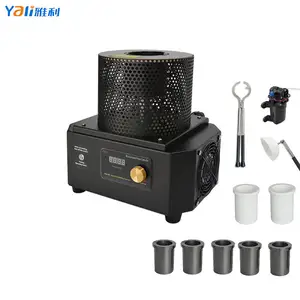
All categories
Featured selections
Trade Assurance
Buyer Central
Help Center
Get the app
Become a supplier

(1872 products available)



























Vacuum arc melting is a crucial process in the development of materials. It is a method where an electrical arc is generated and maintained in a vacuum environment. In this process, the material to be melted serves as the anode, while a water-cooled copper crucible acts as the cathode. The heat generated from the arc causes the material to melt, and the vacuum environment prevents contamination and oxidation, ensuring the creation of high-purity metals and alloys. The molten material can then be solidified to form ingots or further processed to achieve specific material properties. The solidification process can be controlled to produce materials with tailored structures and characteristics, making it a versatile technique in material science and metallurgy.
Vacuum arc melting is extensively used in the production of superalloys, which are essential in industries requiring materials with exceptional mechanical strength and resistance to extreme environments. These applications include aviation, aerospace, and gas turbine manufacturing, where components need to endure high temperatures and corrosive conditions. The aerospace industry, in particular, relies on superalloys for turbine blades, combustion chambers, and other critical parts. The ability of vacuum arc melting to produce materials with precise compositions and microstructures is instrumental in meeting the stringent requirements of these applications.
Vacuum arc melting furnaces are also employed in the production of specialty steels. These steels, such as tool steels and stainless steels, are known for their superior wear resistance, hardness, and corrosion resistance. The controlled solidification process of vacuum arc melting allows for the incorporation of alloying elements in precise amounts, leading to the development of steels tailored for specific applications. Moreover, the vacuum environment ensures the production of steels with minimal impurities, contributing to their high quality and performance. The automotive, tooling, and construction industries benefit from the use of these specialty steels in manufacturing components that require exceptional mechanical properties.
The production of high-purity materials is vital in industries such as electronics and semiconductor manufacturing. Vacuum arc melting is utilized to produce materials with low impurity levels, such as silicon and germanium, which are crucial for electronic components and semiconductor devices. The ability to achieve precise control over material composition and purity makes vacuum arc melting a preferred method in the production of materials for the electronics industry. It ensures the reliability and performance of electronic devices, including integrated circuits, solar cells, and optical components.
The aerospace industry, in particular, relies on superalloys for turbine blades, combustion chambers, and other critical parts. The ability of vacuum arc melting to produce materials with precise compositions and microstructures is instrumental in meeting the stringent requirements of these applications. Vacuum arc melting furnaces are also employed in the production of specialty steels. These steels, such as tool steels and stainless steels, are known for their superior wear resistance, hardness, and corrosion resistance. The controlled solidification process of vacuum arc melting allows for the incorporation of alloying elements in precise amounts, leading to the development of steels tailored for specific applications. Moreover, the vacuum environment ensures the production of steels with minimal impurities, contributing to their high quality and performance. The automotive, tooling, and construction industries benefit from the use of these specialty steels in manufacturing components that require exceptional mechanical properties.